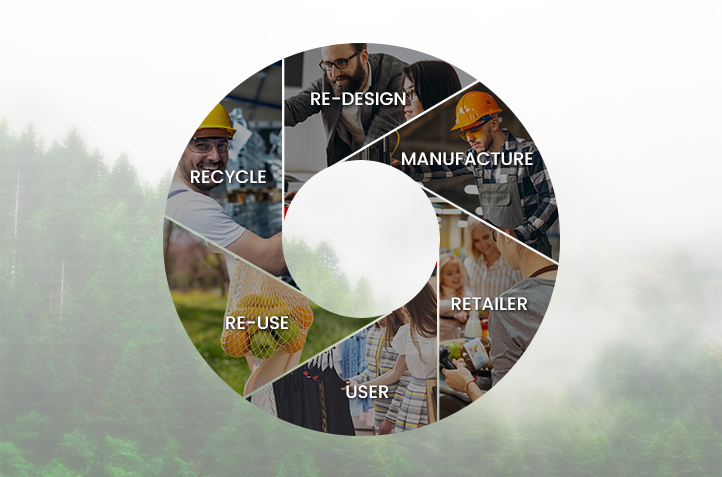“The world is changing. It is changing so rapidly that if we do not take the chance to make the right decisions, the consequences will be dire.”
The past year has been a challenging year for all and despite that, the world could barely standstill. With a pandemic on our head, we already had our hands full with climate change and yet, businesses found a way to operate. During lockdown around the world, organizations discovered an unusual yet functional way of operating remotely with zero impact on their strategies to deploy a circular economy model.
Currently, we are facing climate change that is a direct threat to humanity. International cooperation committees have joined their hands in funding and devising solutions that can power climate action plans to promote a more sustainable life for the generations to come. There have been many solutions, many executed, and many still under process. Everyone’s efforts are going to create an impact to combat climate change and to make that conceivable and efficient, a circular economy model needs to be adopted by industry leaders to promote greener solutions.
Current Position
Many industry giants are onboard building green solutions and encouraging the practice in their respective sectors by supporting government policies. When the legislators are facilitating the businesses to opt for green solutions, the chances are that the business would follow through with anything that saves their costs without degrading their brand.
Another important observation is that people are individually willing to achieve zero waste with composting habits and buying recyclable or recycled goods. Given that individual interest has increased, the businesses are more than likely to align their goals and operations keeping the circular economy model in the center of it all. According to the Science-Based Initiative, over 1,000 companies have committed to set emissions reduction targets based on science, and more than 340 have committed to set net-zero targets across their operations and value chains. The net-zero targets align with limiting warming to 1.5 degrees C (2.7 degrees F).
The awareness amongst the stakeholders of all the industries has risen ever since the governments have aligned their goals for climate action. In 2020, a pandemic triggered a rapid global response which indicates that fighting climate change is only within the hands of companies like YFC and others that are operating with a purpose to reduce global emissions and stop the impact of climate change.
Let’s delve further into these significant trends in the Circular Economy sphere that were observed in 2020 in different industries!
Manufacturing Industry
Perhaps this is where Circular Economy can be related the most closely. The goods produced by one company, their waste is given to another company to be used to produce another new product. The most common example that can be used here is that of glass. Since glass is 100% recyclable without ever having a loss in quality, manufacturers can reuse it over and over again. Raw materials are reheated and recycled to produce different products and then sold to whoever needs them. This saves the cost of acquiring new raw materials and reduces pollution. It’s a win-win and more and more companies are now getting into it. It is not limited to only glass but to many other materials as well. Want to know if you can recycle your products to save money? Click here to reach out to our reps and we will sort you out!
Clothing Industry
One of the more recyclable items that are currently circulating in the world is clothes. Wearing hand-me-downs in families has always been a trend but have you heard of strangers donating their clothes to other strangers? Thrift shops and charity centers aside, there are now organizations that cater to providing reusable clothes for babies and toddlers. Kids from the age of 0-15 grow up at a really fast age and usually end up outgrowing their clothes. These organizations take clothes off from you once the child outgrows them and provide a set for the next size in return. Concepts such as this have stuck with textile industries as now, they are focusing on producing quality over quantity for long-lasting and reusable cloths. According to research, this reduces textile waste from 70-85%.
Automobile Industry
As we move towards more industrialization, the distances between homes and destinations have increased continuously. Even though we are moving forward with electric cars and developing energy-efficient vehicles, there is no denying that more vehicles directly relates to more pollution. Whether it is the emissions from fuel or the old parts that can be thrown away as scrap, Cars and Motor Bikes are one of the biggest contributors to unnecessary waste. Companies such as Uber and Careem have given the concept of the shared economy a new light and now competitors looking to capitalize on the same market are popping up all over the place. It is not clear if the goal behind sharing transport was to reduce pollution but it has become one of the biggest Circular Economy trends in the past few years and will only continue to grow. It’s Carpooling in a Nutshell.
Packaging Industry
Packaging companies have launched Biodegradable bottles made with wood fiber to be used for beverage companies in distributing drinks. These biodegradable bottles are environmentally friendly and pose no threat to the climate action plan. The life of these bottles is thought out as being complete once they are disposed of since they become a resource in the future. This completes the natural circle of life as one might call it. That is also a concept behind the circular economy solution of finding out multiple ways in which waste can be utilized instead of falling into landfills. Previously, glass bottles ended up thrown on beaches and in dumpsters breaking off and being unusable. Now, they have another purpose than just being strewn in many pieces on the floor after usage.
Construction Industry
The construction sector is responsible for generating lots of waste. Once building materials such as bricks, plastics, and metals are thrown away due to deformity or breakage, they remain in that state and end up in landfills. With construction, there is no denying that there is a lot of waste since items like bricks tend to get deformed easily. With architects and builders looking for perfection, a new kind of construction resources has been introduced. Old bricks are cleaned using chemicals and repaired with technology to ensure that they can serve their initial purpose. This saves not only the raw materials needed to create new bricks but also saves 95% of the energy by becoming part of the Circle Economy Solution. Once this trend catches on, builders and construction companies will definitely look to capture this tech to save costs.
What is expected in 2021?
The trends that were observed, have only been increasing in their intensity over the years. Otherwise, the concept has always been there. It takes a lot of effort from sources to take the first step into changing our lifestyles for the better. With more and more companies and individuals looking to adopt Circular Economy in 2021, the experts can predict for more businesses and startups to expand and integrate their solutions that are environmentally friendly similar to the solutions of Yes Full Circle. The adverse effects of not following proper protocols of waste management have already made a big dent in our lives but it’s not too late to make the change.
Want to know more about our plans for this year or need information on how you can be part of the circular economy solution? Follow us on our socials or email us at info@yesfullcircle.com and we would be more than happy to keep you in the loop.

